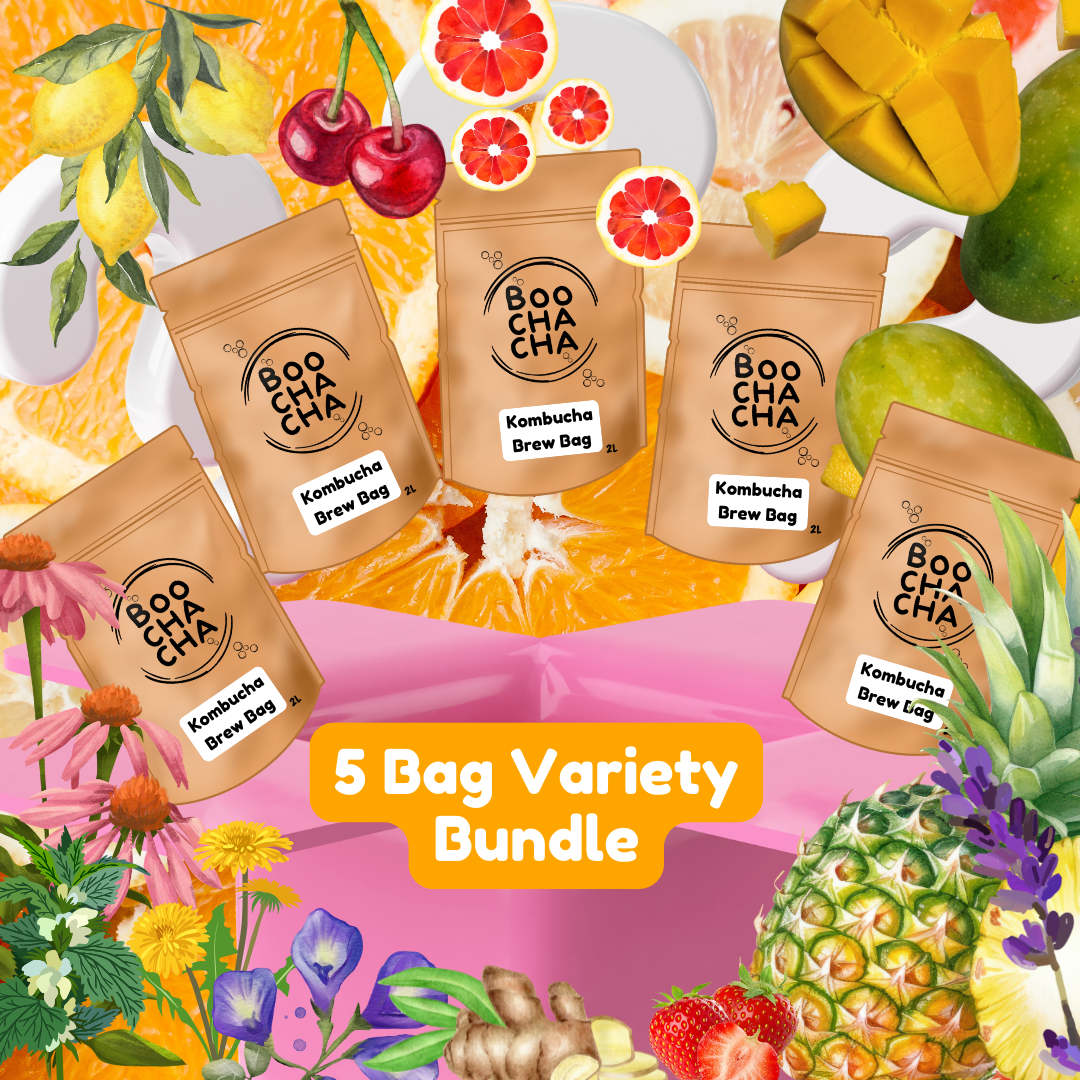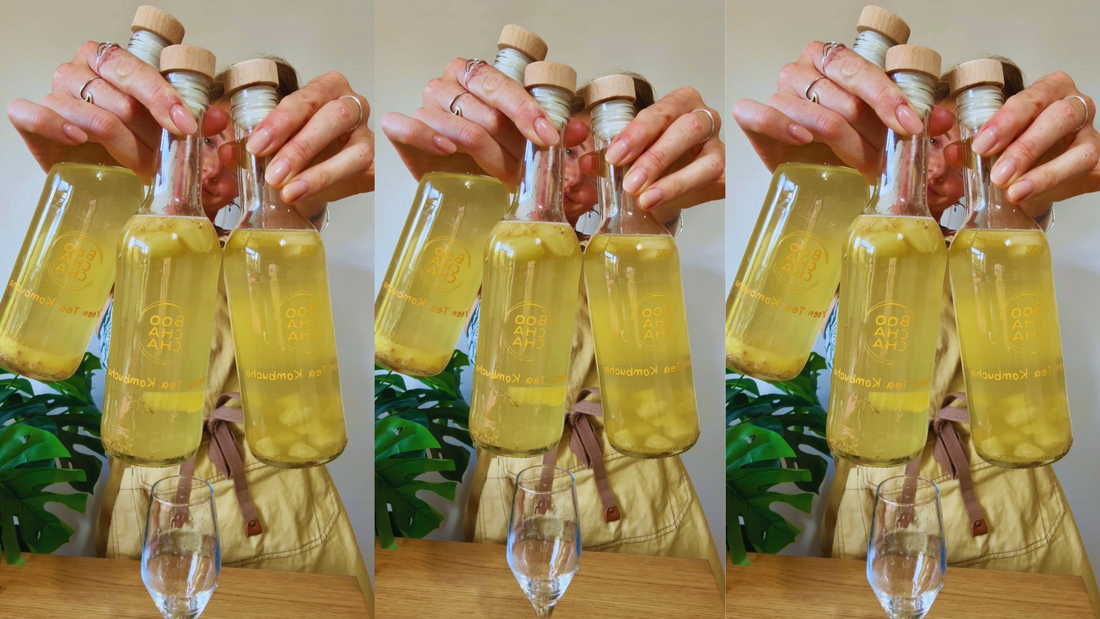For anyone who's thought that Kombucha feels and tastes a little bit like wine, you aren't the only one!
Many people who are used to drinking wine are often struck by how similar Kombucha can be to a young, bright white wine in its texture, body, and finish.
This similarity is one of the reasons Kombucha has become such a popular non-alcoholic beverage alternative for those who want complexity and depth without the alcohol content.
In this blog, we’ll explore why Kombucha has a wine-like mouthfeel, what contributes to that sensory experience, and how you can enhance and flavour your homemade Kombucha so that it more closely resembles a refreshing white wine.
We’ll also walk through some recipes featuring green grapes, pear, lemon rind, and elderflowers to capture that crisp, aromatic essence found in many white wines.
If you haven't started making your own Kombucha at home yet, we have a Kombucha Starter Kit waiting for you! Rated 5 stars for beginners, by beginners and always including our lifetime brewing support, you're guaranteed perfect Kombucha from the first brew.

The Science of Kombucha’s Mouthfeel
The unique texture of Kombucha comes down to the fermentation process. Kombucha is made by fermenting sweet tea with a symbiotic culture of bacteria and yeast, commonly known as a SCOBY (take a peek at our SCOBY gallery here).
During fermentation, the yeast converts sugars into alcohol, and bacteria then convert much of that alcohol (typically leaves trace amounts of alcohol) into organic acids. The result is a drink that contains small amounts of acetic acid, lactic acid, gluconic acid, and other compounds that give Kombucha its slightly tart, but lightly sweet profile.
Mouthfeel is not just about flavour but about texture and sensation on the tongue.
Kombucha has a slightly viscous quality because of the polysaccharides produced during fermentation, giving it body that feels richer than plain soda or juice.
The mild carbonation created during fermentation also adds to this mouthfeel, creating a lightly effervescent sensation reminiscent of sparkling wine. Combined, these elements mirror the structural qualities found in many wines.
Fermentation Differences between Wine and Kombucha
Kombucha fermentation and wine fermentation share more similarities than many people realize, even though they start with very different base ingredients.
In wine, natural or cultured yeasts convert the sugars in grapes into alcohol, and the character of the final wine is shaped by the type of yeast, grape variety, and fermentation conditions.
In Kombucha, a symbiotic culture of bacteria and yeast performs a similar role, with yeast producing alcohol from sugar and bacteria converting much of that alcohol into organic acids.
Both processes rely on a delicate balance of microorganisms, temperature, and time to create layers of complexity.
Where wine emphasizes alcohol, esters, and tannins for structure, Kombucha highlights acidity, carbonation, and living probiotics.
Despite these differences, both beverages create a profile that stimulates the palate in ways far beyond simple juice or soda.

Comparing Kombucha and Wine Sensory Experiences
When you sip white wine, you’ll often notice a balance between acidity, sweetness, body, and aroma. Good white wines like Sauvignon Blanc or Riesling have a crisp acidity that brightens the palate, often accompanied by fruit-forward flavours such as citrus, pear, or apple.
Kombucha mirrors this experience with its tartness and natural effervescence.
With interests around health and wellness rising, people are searching for non-alcoholic drinks beyond sugary juices and sodas, and that is where Kombucha comes in.
One of the hallmarks of wine is how well it pairs with food, and Kombucha shares this quality, especially the ones in our recipes below.
The acidity of Kombucha cuts through rich or fatty foods, just as white wine does, cleansing the palate and preparing it for the next bite.
Its effervescence enhances lighter dishes such as salads, seafood, and fruit-based desserts, offering a sense of sophistication without the alcohol.
For those who want to keep with their ritual of pouring a glass of wine, Kombucha served in a wine glass is a perfect substitute. It can be swirled, the aroma inhaled and the colour and natural bubbles observed.
Flavouring Kombucha to Mimic White Wine
Plain Kombucha is already reminiscent of wine, but by carefully choosing fruits, herbs, and aromatics, you can guide it even closer to a white wine substitute.
Many white wines feature green fruit flavours, delicate floral notes, and refreshing acidity.
Adding ingredients such as green grapes, pear, lemon rind, and elderflowers highlights these qualities and brings out the wine vibes in your Kombucha.
Green grapes contribute sweetness and a familiar grape flavour associated with wine. Pear adds a soft, mellow fruitiness that balances acidity. Lemon rind brings a zesty brightness and the aromatic oils of citrus peel, echoing the freshness of wines like Sauvignon Blanc. Elderflower, often used in liqueurs and sparkling beverages, adds floral complexity, reminiscent of wines with blossom or honeysuckle aromas.
Recipes for White Wine Inspired Kombucha
All the below recipes are for 1 litre of wine style Kombucha, and our Flavouring Your Kombucha Bundle works PERFECTLY for all of these recipes (just make sure you chop your ingredients small enough that they come out the top of the bottle once you've finished).

Recipe 1: Green grape Kombucha
- 950ml green tea Kombucha (we have a Kombucha starter kit for this)
- 10 green grapes sliced
- Optional - sprig of thyme
Add the grapes to a glass fermentation safe bottle with the Kombucha and let it ferment at room temperature for 2 days. Option to add the thyme and leave for another 1-2 days.
The grapes infuse their juice and sweetness, while the fermentation accentuates tartness, mimicking the crispness of a dry white wine. Strain and chill before serving.
Recipe 2: Pear and Elderflower Kombucha
- 950ml green tea Kombucha (we have a Kombucha starter kit for this)
- 1/2 a ripe pear, sliced thinly
- 1/4 teaspoon of dried elderflowers or 1 teaspoon of elderflower cordial
Combine pear slices and elderflowers with the Kombucha in a fermentation safe bottle.
Allow 2 to 3 days for the flavours to develop, then strain and refrigerate.
The pear brings round, gentle fruit notes, while the elderflower contributes floral elegance, echoing aromatic white wines. This combination pairs beautifully with cheese platters or light seafood dishes.
Recipe 3: Lemon Rind Sparkling Kombucha
- 950ml green tea Kombucha (we have a Kombucha starter kit for this)
- Rind of 1/2 an organic lemon, sliced thinly avoiding too much pith
- Optional - a slice of fresh ginger
Add lemon rind strips and ginger if using to the Kombucha in a fermentation safe bottle, ensuring they are thin enough to release aromatic oils. Let the Kombucha ferment for 2 to 3 days.
The lemon oils provide a zesty freshness, enhancing the crisp acidity of the Kombucha and creating a lively, sparkling experience that is very close to sipping a zesty Sauvignon Blanc. Chill before drinking for maximum refreshment.
Recipe 4: White Wine Style Blend (Our favourite)
- 900ml green tea Kombucha (we have a Kombucha starter kit for this)
- 10 green grapes sliced
- 1/2 a ripe pear, sliced thinly
- 1/4 teaspoon of dried elderflowers or 1 teaspoon of elderflower cordial
- Rind of 1/2 an organic lemon, sliced thinly avoiding too much pith
Combine all ingredients in a fermentation safe bottle with Kombucha for 2 to 4 days. The grapes and pear provide balanced fruitiness, the lemon rind sharpens the acidity, and elderflowers add aromatic lift.
This blend is perhaps the closest you’ll get to Kombucha tasting like a refined glass of white wine.
Serve chilled in a stemmed glass over a good dinner for full effect.
All of these recipes also work beautifully in a Rooibos or Classic Kombucha base, and we also loved the deep colour given by the Rooibos and Hibiscus Kombucha Brew Bag, so don't be nervous to experiement with different combos of tea bases and ingredients.
Tips for Flavouring Kombucha Successfully
When flavouring Kombucha, it’s important to remember that secondary fermentation not only enhances flavour but also continues carbonation.
Always use bottles designed for pressure, such as swing-top bottles, to avoid accidents. We have some extra tips on preventing explosions in this blog here.
Taste your brew daily, as flavours can shift quickly. If you want a sweeter profile, refrigerate sooner to halt fermentation; if you prefer drier, more tart flavours, let it go longer.

Experimenting with small batches is a good way to test new combinations. You may find that adding a hint of herbal flavour, such as mint or basil, enhances the wine-like qualities.
Similarly, floral additions like chamomile or jasmine can replicate some of the delicate notes found in certain white wines.
Serving Kombucha as a White Wine Alternative
Presentation plays a huge role in the drinking experience. Pour your flavoured Kombucha into a clean wine glass to highlight its effervescence and aromas.
Just like wine, Kombucha benefits from being served chilled, which enhances its refreshing qualities and balances acidity.
Pair it thoughtfully with meals. Kombucha with lemon rind pairs beautifully with seafood, while pear and elderflower Kombucha complements creamy cheeses.
Green grape Kombucha works wonderfully alongside salads and light pasta dishes. By serving your Kombucha with the same care given to wine, you elevate the experience and create a satisfying alternative.

Kombucha is more than just a trendy fermented tea. Its unique texture, natural carbonation, and complex flavour profile make it remarkably similar to wine in mouthfeel and drinking experience.
With the right choice of fruits, herbs, and aromatics, Kombucha can step into the role of white wine for anyone looking for a sophisticated, non-alcoholic alternative, the only question is; which recipe will you be trying first?


